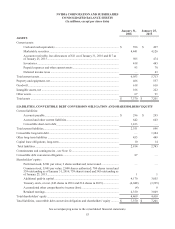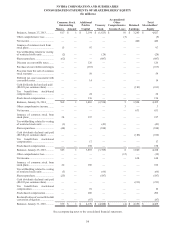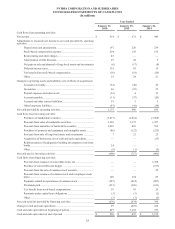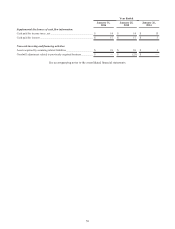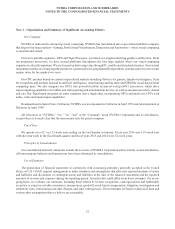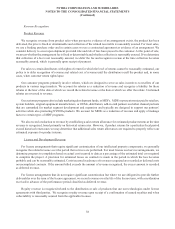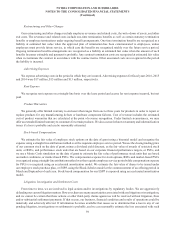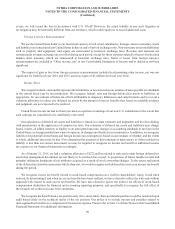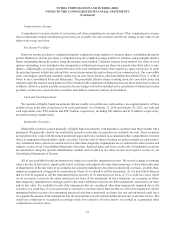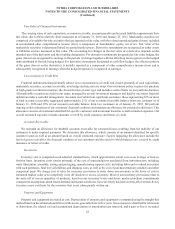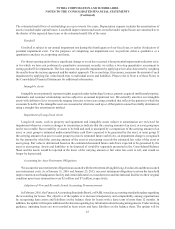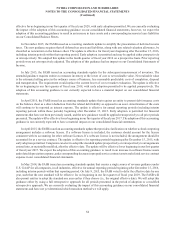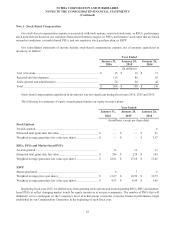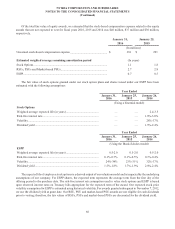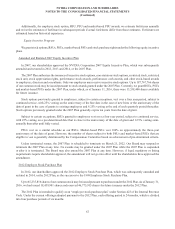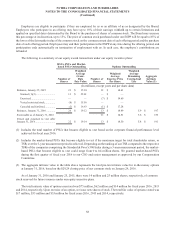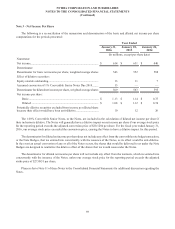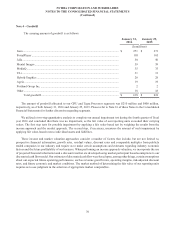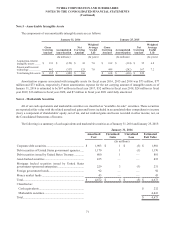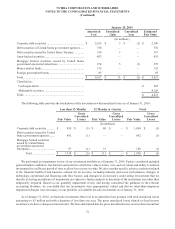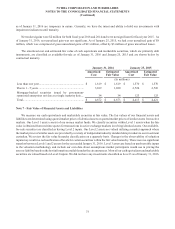NVIDIA 2016 Annual Report Download - page 209
Download and view the complete annual report
Please find page 209 of the 2016 NVIDIA annual report below. You can navigate through the pages in the report by either clicking on the pages listed below, or by using the keyword search tool below to find specific information within the annual report.NVIDIA CORPORATION AND SUBSIDIARIES
NOTES TO THE CONSOLIDATED FINANCIAL STATEMENTS
(Continued)
63
The estimated useful lives of our buildings are up to twenty five years. Depreciation expense includes the amortization of
assets recorded under capital leases. Leasehold improvements and assets recorded under capital leases are amortized over
the shorter of the expected lease term or the estimated useful life of the asset.
Goodwill
Goodwill is subject to our annual impairment test during the fourth quarter of our fiscal year, or earlier if indicators of
potential impairment exist. For the purposes of completing our impairment test, we perform either a qualitative or a
quantitative analysis on a reporting unit basis.
For those reporting units where a significant change or event has occurred, where potential impairment indicators exist,
or for which we have not performed a quantitative assessment recently, we utilize a two-step quantitative assessment to
testing goodwill for impairment. The first step tests for possible impairment by applying a fair value-based test by weighing
the results from the income approach and the market approach. The second step, if necessary, measures the amount of such
impairment by applying fair value-based tests to individual assets and liabilities. Please refer to Note 4 of these Notes to
the Consolidated Financial Statements for additional information.
Intangible Assets
Intangible assets primarily represent rights acquired under technology licenses, patents, acquired intellectual property,
trademarks and customer relationships and are subject to an annual impairment test. We currently amortize our intangible
assets with definitive lives over periods ranging from one to ten years using a method that reflects the pattern in which the
economic benefits of the intangible asset are consumed or otherwise used up or, if that pattern cannot be reliably determined,
using a straight-line amortization method.
Impairment of Long-Lived Assets
Long-lived assets, such as property and equipment and intangible assets subject to amortization are reviewed for
impairment whenever events or changes in circumstances indicate that the carrying amount of an asset, or asset group may
not be recoverable. Recoverability of assets to be held and used is measured by a comparison of the carrying amount of an
asset, or asset group to estimated undiscounted future cash flows expected to be generated by the asset, or asset group. If
the carrying amount of an asset or asset group exceeds its estimated future cash flows, an impairment charge is recognized
for the amount by which the carrying amount of the asset or asset group exceeds the estimated fair value of the asset or
asset group. Fair value is determined based on the estimated discounted future cash flows expected to be generated by the
asset or asset group. Assets and liabilities to be disposed of would be separately presented in the Consolidated Balance
Sheet and the assets would be reported at the lower of the carrying amount or fair value less costs to sell, and would no
longer be depreciated.
Accounting for Asset Retirement Obligations
We account for asset retirement obligations associated with the retirement of tangible long-lived assets and the associated
asset retirement costs. As of January 31, 2016 and January 25, 2015, our asset retirement obligations to return the leasehold
improvements at our headquarters facility and certain laboratories at our domestic and international facilities to their original
condition upon lease termination were $2 million and $7 million, respectively.
Adoption of New and Recently Issued Accounting Pronouncements
In February 2016, the Financial Accounting Standards Board, or FASB, issued an accounting standards update regarding
the accounting for leases. The objective of the update is to increase transparency and comparability among organizations
by recognizing lease assets and liabilities on the balance sheet for leases with a lease term of more than 12 months. In
addition, the update will require additional disclosures regarding key information about leasing arrangements. Under existing
guidance, operating leases are not recorded as lease assets and lease liabilities on the balance sheet. The update will be


